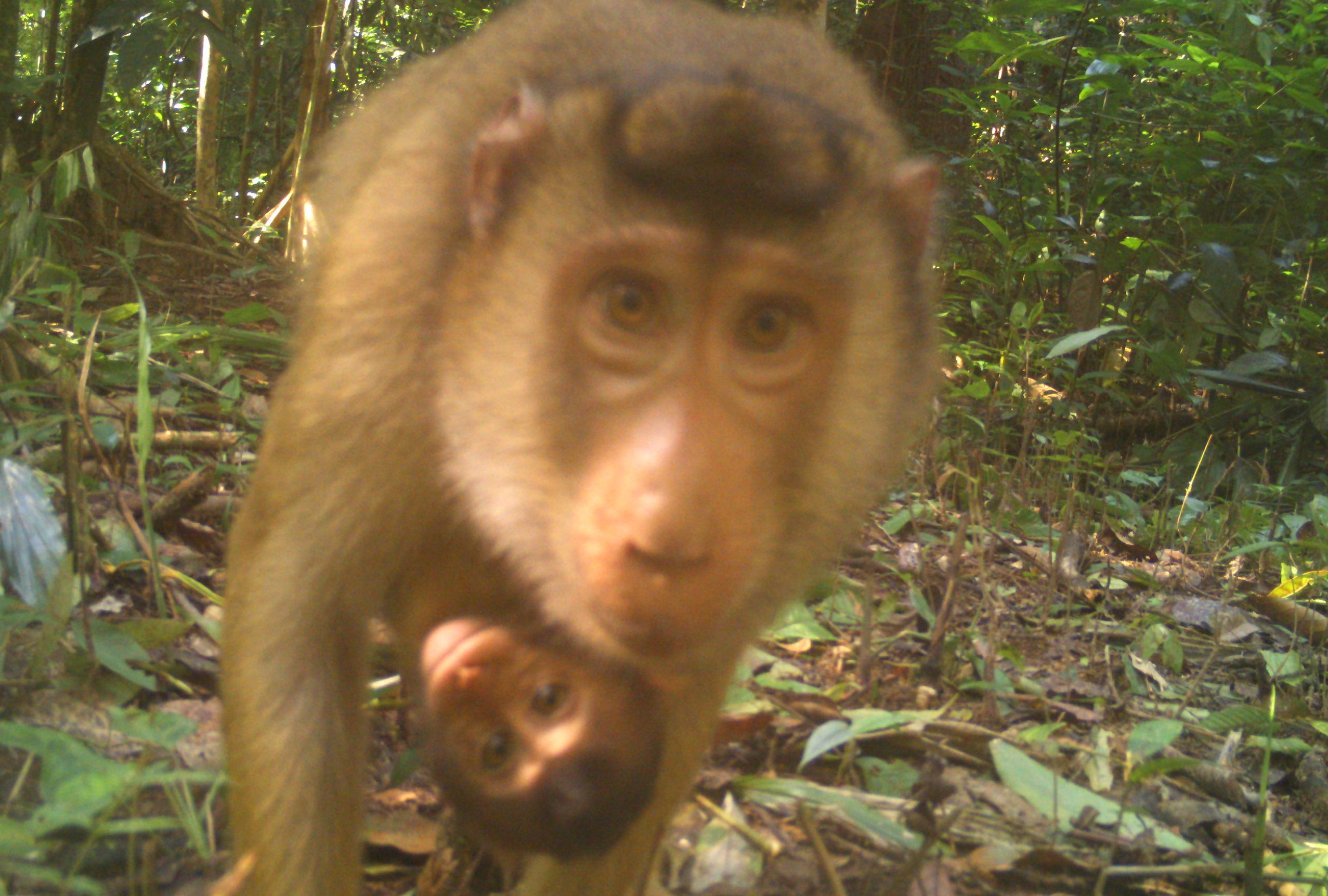- A new study documents the “hyperabundance” of two generalist mammals around oil palm plantations in Southeast Asia, highlighting the indirect ecological impacts of oil palm expansion across the region.
- The research team found local numbers of wild pigs and macaques “exploded” in proximity to oil palm plantations, where they believe the animals derive enormous fitness benefits by consuming high-calorie palm fruit.
- Scientists caution that while these species can aggregate in some areas, their overall numbers are in decline due to a wide range of threats, including habitat loss, environmental degradation, disease outbreak, and poaching for the pet trade and biomedical research.
- The researchers call for the establishment of buffer zones around oil palm plantations and avoiding encroachment into intact forest as a way to address any problems arising from negative human-wildlife interactions and ecological impacts.
Many wild animals are wise to the fact that where there are humans, there is typically food — often a cornucopia of food. A new study documents dramatically elevated numbers of two generalist mammals around oil palm plantations in Southeast Asia, where the research team believe they derive enormous benefits from eating high-calorie palm fruit.
The researchers looked at two decades’ worth of camera trap data in a range of degraded and intact habitats across the region, finding what they term a “hyperabundance” of two monkey and two pig species — long-tailed macaques (Macaca fascicularis), pig-tailed macaques (M. nemestrina), bearded pigs (Sus barbatus) and wild boar (S. scrofa) — in proximity to oil palm plantations.
While prior studies have documented wild boars and macaques “raiding” plantations for palm fruit and their general preference for forest edge habitats, the intensity of their attraction to oil palm above all other land uses analyzed in the new study is more extreme than previously reported, Jonathan Moore, lead author of the study and Ph.D. candidate at the University of East Anglia in the U.K., told Mongabay.
“These species are tolerant in degraded landscapes, but when you add oil palm into the mix, it just makes the populations explode,” Moore said. “They have an unlimited food source [the palm fruit], and they can benefit and reproduce as much as they like, so there is no longer any limitation on their population size.”
These four species species accounted for some 80% of the 164,055 camera trap detections Moore and his colleagues analyzed across 58 separate habitats. In landscapes with more than 60% oil palm coverage, wild boar and pig-tailed macaques were 337% and 447% more abundant respectively, compared to landscapes with very little oil palm. The team published their findings in Biological Reviews.

Cascading impacts on nearby ecosystems
The gravitation of hefty herds of pigs and troops of macaques toward oil palm could have cascading impacts on the natural ecology of intact forests surrounding plantations. According to the study, both types of mammal are capable of outcompeting or predating on sensitive forest species, and wild boar have been shown to heavily degrade forest vegetation surrounding oil palm plantations when they’re locally overly abundant.
Scientists not involved in the study caution, however, that we must not overlook the many positive effects macaques and wild pigs have on ecosystems when they’re present at normal population densities. Through seed dispersal and soil turnover, they enable forest plants to thrive, for instance, and by eating a wide range of prey, including rats, they provide natural pest control.
Nadine Ruppert, a primatologist and conservation biologist at Universiti Sains Malaysia, who was not involved in the study, questioned whether the new study’s use of camera-trap data is a sufficiently reliable method of calculating abundances of group-living primates like macaques.
“There’s a few issues with camera trapping to calculate real abundances in open populations, such as how to assess independent sightings and avoid double counting the same individuals, and the quite different detection probabilities of arboreal and terrestrial species when using ground camera traps,” Ruppert told Mongabay, adding that long-tailed macaques spend a lot of time in the tree canopy, whereas pig-tailed macaques are largely ground-dwelling.

Ruppert said it’s crucial that the new study findings aren’t interpreted as a sign that the four species highlighted are doing well. The overall populations of all four species are struggling due to a wide range of differing threats, she said, including habitat loss, environmental degradation, disease outbreak, and poaching for the pet trade and biomedical research.
Bearded pig and wild boar populations have both suffered recent population crashes due to outbreaks of African swine fever that have ripped through parts of Southeast Asia since 2018. Meanwhile, long-tailed macaques and pig-tailed macaques are both listed as endangered on the IUCN Red List, with long-term monitoring data suggesting both species are in sharp decline in many parts of their range.
Kurnia Ilham, a long-tailed macaque researcher at Andalas University in Indonesia, who was not involved in the study, told Mongabay that long-tailed macaque numbers are in “significant” decline in Indonesia. This is “tied to habitat alteration, overexploitation for biomedical research and killing by local people due to crop damage,” Kurnia told Mongabay in an email. “We urgently need to take the necessary measures to mitigate the extinction risk of this species.”
“These species need attention to better protect them … various populations are in fact declining,” Ruppert said. “In these oil palm plantations where [pig-tailed macaques] seem to be thriving as mentioned in the new study, in fact, they could also be locally declining because in our study population in Perak [state in Malaysia] over the span of 10 years, we assessed infant mortality and that can sometimes reach 100% in a year. We’re losing these young individuals and we think there could be issues with pesticides in agricultural landscapes that can have long-term effects on mammalian fitness that might not be immediately visible right now, but maybe will become a more concerning threat down the line, in two or three generations.”

Ruppert said the elevated numbers of animals around oil palm plantations is unlikely to be down to high population turnover or enhanced reproductive output. What is more likely at play is that animals are coming out of the forest to “seek out places near forest edges where humans are present,” she said, so their numbers deeper in the forest are diminishing.
“From a human perspective, we may see 40 [macaques] in one open spot near the forest edge and automatically assume that there are maybe 400 more in the immediate natural surroundings that we cannot see,” she said. “But in reality, there might actually just be 40 macaques in the whole of the wider area, including the forest.”
Oil palm plantations need buffer zones
Notwithstanding how local numbers compare to overall populations sizes, Moore agreed that the basic ecology of the four species highlighted in the study is not at fault. “It’s not the animals … they’re just taking advantage of a food source that they can consume easily,” he said. “It’s us as humans modifying the landscape and planting oil palm everywhere [that triggers] problems associated with hyperabundance.”

Moore added that besides their impacts on nearby forest ecosystems, aggregations of pigs and macaques are often viewed as a nuisance, necessitating careful and at times expensive mitigation measures to manage their interactions with people.
He also warned that aggregations of wild animals in close proximity to humans can be potential disease reservoirs, heightening the risk of zoonotic disease transfer to humans. However, primate specialists not involved with the study told Mongabay that there’s no data-backed evidence that either free-ranging macaques or wild pigs can communicate disease to humans.
Moore and his colleagues called on the oil palm industry and governments in producer countries to avoid encroachment into intact forest and to establish buffer zones around plantations as a way to limit wildlife access to oil palm fruit and reduce the likelihood of large aggregations of generalist species and their associated knock-on consequences for surrounding forests and people.
“There’s not many ways to stop these species from going into the oil palm,” Moore said. “Avoiding building oil palm plantations close to forests is the only way to really stop this from happening … otherwise the plantations will keep having these cascading effects.”
Carolyn Cowan is a staff writer for Mongabay. Follow her on Twitter @CarolynCowan11.
Banner image: A camera-trap photo of a pig-tailed macaque in a lowland tropical forest. Image courtesy of Jonathan Moore.
Citation:
Moore, J. H., Gibson, L., Amir, Z., Chanthorn, W., Ahmad, A. H., Jansen, P. A., … Luskin, M. S. (2023). The rise of hyperabundant native generalists threatens both humans and nature. Biological Reviews. doi:10.1111/brv.12985
FEEDBACK: Use this form to send a message to the author of this post. If you want to post a public comment, you can do that at the bottom of the page.




